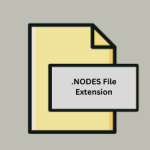.RAM File Extension

Real Audio Metadata File
| Developer | RealNetworks |
| Popularity | |
| Category | Audio Files |
| Format | .RAM |
| Cross Platform | Update Soon |
What is an RAM file?
.RAM (RealMedia Metafile) file extension is primarily associated with the streaming of multimedia content over the internet.
It’s a format developed by RealNetworks and is often used in conjunction with RealPlayer, a multimedia playback and streaming software.
.RAM files don’t contain actual multimedia content but rather text instructions that direct a player to the location of the real media content, typically hosted on a network.
More Information.
During the early days of the internet, streaming real-time media was a significant challenge due to bandwidth limitations and the lack of sophisticated streaming technology.
The .RAM file format was created in this context. Its initial purpose was to facilitate the streaming of audio and video content by pointing the media player to the direct location of the streaming content, thus enabling the content to be played without a complete download.
Origin Of This File.
The .RAM file format was introduced by RealNetworks, a company historically significant for its advancements in media streaming technology.
The format was developed to complement the company’s RealPlayer software, providing a solution for easily accessing and streaming media content without the need to download large files.
File Structure Technical Specification.
.RAM files are essentially text files that contain a link to the actual media file, which is typically in the .RM (RealMedia) format. The .RAM file itself is small since it only contains text.
When a .RAM file is opened in a compatible media player, the player reads the URL contained in the file, connects to the server where the media file is hosted and begins streaming the content.
The simplicity of .RAM files is also one of their defining characteristics. A typical .RAM file can be opened and edited with a basic text editor, as it’s just a plain text file with a URL pointing to the location of the media content.
How to Convert the File?
Converting .RAM files to other multimedia formats is not a direct process, given that .RAM files themselves don’t contain the media content.
You can convert the actual media content (pointed to by the .RAM file) into other formats by following these steps:
- Access the Actual Media Content: Open the .RAM file in a text editor, copy the URL, and use it to access the media content directly in a web browser.
- Download the Media Content: Once accessed, the media content can often be downloaded.
- Use a Media Converter: After downloading, use a reliable media converter tool to convert the downloaded file to the desired format.
Advantages And Disadvantages.
Advantages:
- Efficiency in Streaming: .RAM files allow for the efficient streaming of multimedia content by directly linking to the source, reducing the need for downloading large media files.
- Simplicity: The format is simple, containing just the necessary information to direct a player to the media content.
- Compatibility with RealPlayer: .RAM files are designed to work seamlessly with RealPlayer, which was one of the pioneering software solutions for media streaming.
Disadvantages:
- Dependence on RealPlayer: The primary disadvantage of .RAM files is their dependence on RealPlayer or compatible software, which limits their usability.
- Limited Support: As newer technologies have emerged, the support for .RAM files and RealPlayer has dwindled, making the format less practical for modern applications.
- Vulnerability to Link Rot: Since .RAM files rely on URLs to stream content, they are susceptible to link rot (the URL becoming invalid over time), rendering the .RAM file useless.
How to Open RAM?
Open In Windows
- RealPlayer: The most straightforward way to open .RAM files is by using RealPlayer, which automatically handles the streaming of the content.
- VLC Media Player: VLC is a versatile media player that supports a wide range of formats, including .RAM files.
Open In Linux
- RealPlayer for Linux: While official support may vary, legacy versions of RealPlayer for Linux can open .RAM files.
- VLC for Linux: VLC, available for various Linux distributions, is capable of playing .RAM files.
Open In MAC
- RealPlayer for Mac: RealPlayer is also available for Mac and can be used to open .RAM files.
- VLC for Mac: VLC is also a viable option for Mac users to open and stream .RAM files.













